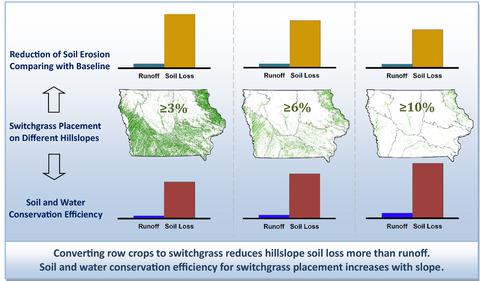当前位置:
X-MOL 学术
›
GCB Bioenergy
›
论文详情
Our official English website, www.x-mol.net, welcomes your feedback! (Note: you will need to create a separate account there.)
Strategic switchgrass (Panicum virgatum) production within row cropping systems: Regional‐scale assessment of soil erosion loss and water runoff impacts
Global Change Biology Bioenergy ( IF 5.6 ) Pub Date : 2020-09-04 , DOI: 10.1111/gcbb.12749 Enheng Wang 1 , Richard M. Cruse 2 , Bharat Sharma‐Acharya 3 , Daryl E. Herzmann 2 , Brian K. Gelder 4 , David E. James 5 , Dennis C. Flanagan 6 , Humberto Blanco‐Canqui 7 , Robert B. Mitchell 8 , David A. Laird 2
Global Change Biology Bioenergy ( IF 5.6 ) Pub Date : 2020-09-04 , DOI: 10.1111/gcbb.12749 Enheng Wang 1 , Richard M. Cruse 2 , Bharat Sharma‐Acharya 3 , Daryl E. Herzmann 2 , Brian K. Gelder 4 , David E. James 5 , Dennis C. Flanagan 6 , Humberto Blanco‐Canqui 7 , Robert B. Mitchell 8 , David A. Laird 2
Affiliation

|
A strong need exists for tools to assess the efficacy of conservation practices across large regions supporting informed policy decisions that may lead to better soil and water conservation while optimizing agricultural production options. Perennial warm‐season grasses (WSGs) such as switchgrass (Panicum virgatum), can be grown on marginally productive and/or environmentally sensitive lands to meet growing bioenergy demands while reducing water runoff and soil erosion compared to current row crop systems. Quantifying the soil and water conservation effects of WSG when strategically placed on the landscape would help support decisions favoring both economic and environmental benefits. We used the Daily Erosion Project (DEP) to simulate the effects of WSGs on hillslope water runoff and soil loss for 2008–2016 across eight major land resource areas (MLRA) in the Midwest United States. Four different scenarios (baseline or existing conditions and switchgrass grown on slopes ≥3%, ≥6%, and ≥10%) were modeled. Across all hillslope groups replacing row crops with switchgrass reduced yearly water runoff and soil loss by 3.2%–12.1% and 43.7%–95.5% compared with the baseline levels, respectively. Water and soil conservation efficiency (water runoff reductions or soil loss reductions associated with 1% increase in switchgrass coverage) increased with slope as 10% > 6% > 3% for all MLRAs. Switchgrass replacement on slopes ≥10% reduced average soil loss estimates as much as 22.6 Mg ha−1 year−1 for the most erosive MLRA (baseline soil erosion rate of 28.6 Mg ha−1 year−1) and resulted in all MLRA erosion estimates ≤6.0 Mg ha−1 year−1. For soil loss, an apparent interaction existed between slope group and total annual precipitation; as annual precipitation increased, the difference in soil loss between slope groups increased. Soil loss was more sensitive to these factors than was water runoff. Policy supporting a renewable energy industry while strategically improving soil and water resources seems globally advantageous.
中文翻译:

大田种植系统内的战略柳枝草(Panicum virgatum)生产:水土流失和径流影响的区域规模评估
迫切需要一种工具来评估跨大区域的保护措施的有效性,以支持知情的政策决策,这些决策可能导致更好的水土保持,同时优化农业生产选择。多年生暖季草(WSG),如柳枝((Panicum virgatum),可以种植在边际生产力和/或对环境敏感的土地上,以满足不断增长的生物能源需求,同时与目前的大田作物系统相比,可以减少水径流和土壤侵蚀。在战略上将WSG放置在景观上时,对其水土保持效果进行量化将有助于支持有利于经济和环境利益的决策。我们使用“每日侵蚀项目”(DEP)模拟了美国中西部八个主要土地资源区域(MLRA)上WSG对2008-2016年坡面水径流和土壤流失的影响。对四种不同的情况(基线或现有条件以及在≥3%,≥6%和≥10%的坡度上生长的柳枝switch)进行了建模。在所有的山坡群中,用柳枝replacing代替大田作物后,每年的水径流和土壤流失减少了3.2%–12.1%和43.7%–95。与基准水平相比,分别降低了5%。所有MLRA的水土保持效率(与柳枝coverage覆盖率增加1%相关的水径流减少或水土流失减少)随所有MLRA的坡度增加10%> 6%> 3%。坡度≥10%的柳枝replacement替换降低了平均土壤流失估计值,至多22.6 Mg ha-1 年-1为最糜烂MLRA(28.6镁的基线土壤侵蚀速率公顷-1 年-1),并导致所有MLRA侵蚀估计≤6.0镁公顷-1 年-1。对于土壤流失,边坡群与年降水总量之间存在明显的相互作用。随着年降水量的增加,边坡群之间土壤流失的差异增加。与流失相比,水土流失对这些因素更敏感。在战略上改善土壤和水资源的同时,支持可再生能源产业的政策在全球看来是有利的。
更新日期:2020-10-15
中文翻译:

大田种植系统内的战略柳枝草(Panicum virgatum)生产:水土流失和径流影响的区域规模评估
迫切需要一种工具来评估跨大区域的保护措施的有效性,以支持知情的政策决策,这些决策可能导致更好的水土保持,同时优化农业生产选择。多年生暖季草(WSG),如柳枝((Panicum virgatum),可以种植在边际生产力和/或对环境敏感的土地上,以满足不断增长的生物能源需求,同时与目前的大田作物系统相比,可以减少水径流和土壤侵蚀。在战略上将WSG放置在景观上时,对其水土保持效果进行量化将有助于支持有利于经济和环境利益的决策。我们使用“每日侵蚀项目”(DEP)模拟了美国中西部八个主要土地资源区域(MLRA)上WSG对2008-2016年坡面水径流和土壤流失的影响。对四种不同的情况(基线或现有条件以及在≥3%,≥6%和≥10%的坡度上生长的柳枝switch)进行了建模。在所有的山坡群中,用柳枝replacing代替大田作物后,每年的水径流和土壤流失减少了3.2%–12.1%和43.7%–95。与基准水平相比,分别降低了5%。所有MLRA的水土保持效率(与柳枝coverage覆盖率增加1%相关的水径流减少或水土流失减少)随所有MLRA的坡度增加10%> 6%> 3%。坡度≥10%的柳枝replacement替换降低了平均土壤流失估计值,至多22.6 Mg ha-1 年-1为最糜烂MLRA(28.6镁的基线土壤侵蚀速率公顷-1 年-1),并导致所有MLRA侵蚀估计≤6.0镁公顷-1 年-1。对于土壤流失,边坡群与年降水总量之间存在明显的相互作用。随着年降水量的增加,边坡群之间土壤流失的差异增加。与流失相比,水土流失对这些因素更敏感。在战略上改善土壤和水资源的同时,支持可再生能源产业的政策在全球看来是有利的。


























 京公网安备 11010802027423号
京公网安备 11010802027423号